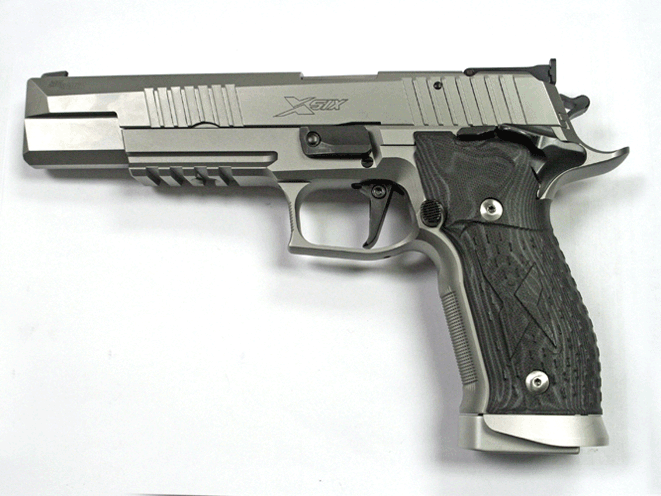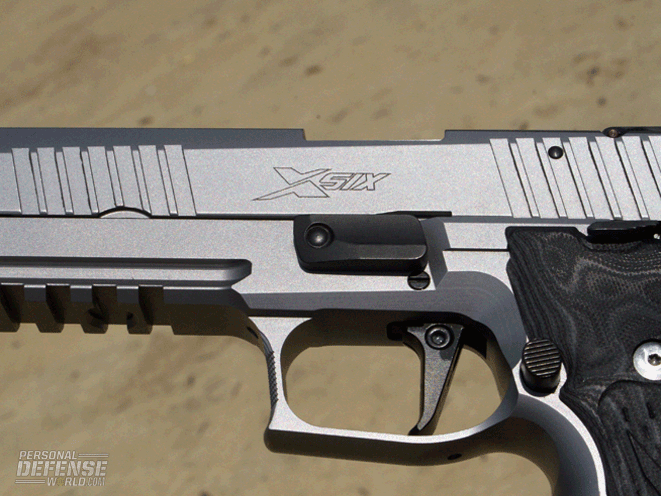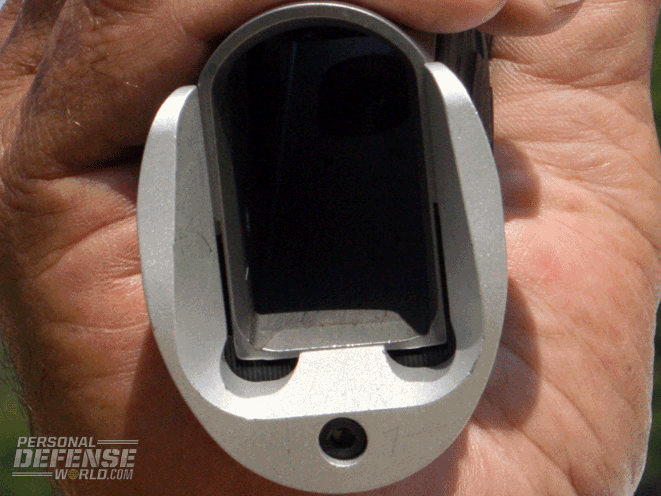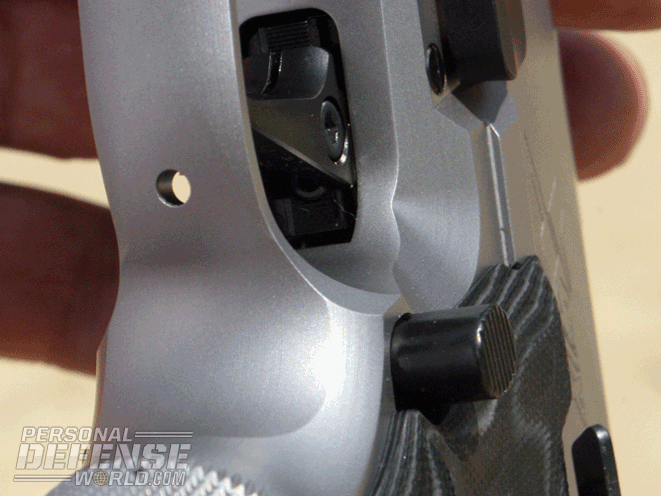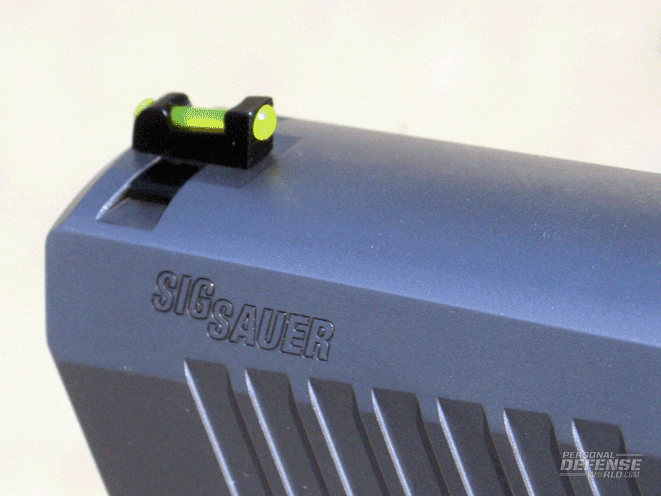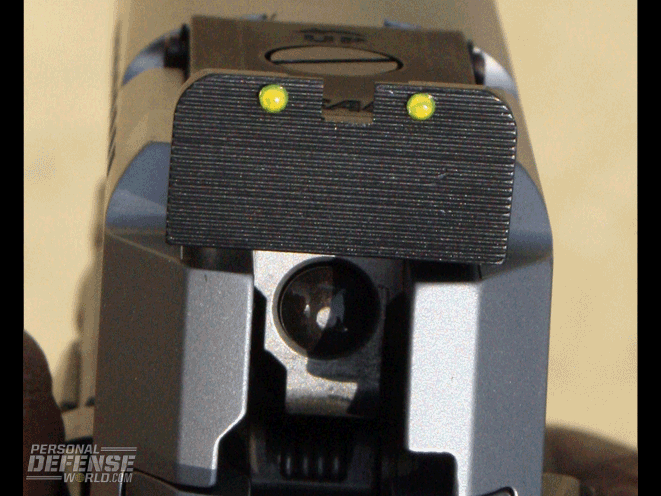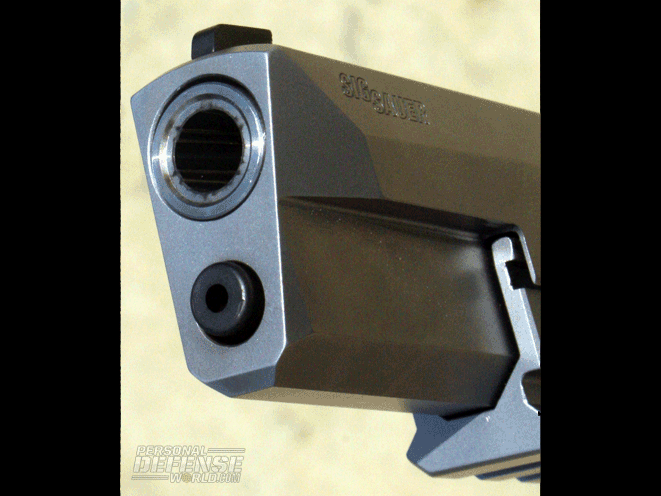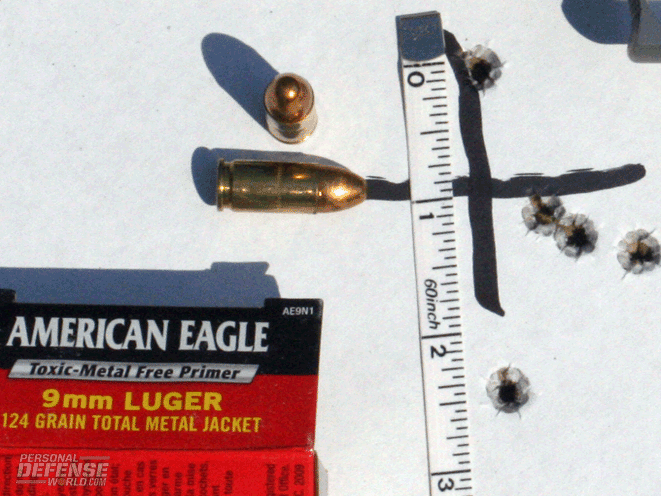The front sight of the heavy stainless pistol in your hand settles on the tiny spot about 100 yards downrange. It’s a Styrofoam cup drained of every purpose but to be a target. You apply a gentle touch to the light trigger, and you see the sights move back and forth on the slide, though the pistol itself barely elevates at the shot. The cup jumps, surrounded by a nimbus of sand from the backstop. Well, that went well. You try it again. Another hit. And another. You put the pistol on safe and index your trigger finger along the frame. You like this pistol. For almost $3,000 retail, you bloody well should.
So, there we were at a shooting session at the fabulous Sig Sauer Academy range in New Hampshire. I was there to do an update on the company for the second edition of The Gun Digest Book of Sig Sauer. We had shot a variety of new Sig Sauers: the suppressed models with silencers produced in-house, demanded for some government contracts; the P227, a very sweet, higher-capacity version of the great old P220 .45 ACP; the single-action-only version of the classic P226 9mm; and more.
If you were touring Ford, your hosts might give you a ride in their highest-performance offering, the Boss Mustang. Sig Sauer did something similar (though they’re generally more often compared to Mercedes than to Ford), and trotted out its new 9mm X-Six target pistol.
Advertisement — Continue Reading Below
I understand why the company did. Sig Sauer is proud of both its design and its workmanship—and the X-Six pistol is a veritable showpiece of both. It was a fitting piece de resistance.
Gun Details

For a while now, Sig Sauer’s answer to Smith & Wesson’s Performance Center and Springfield Armory’s Custom Shop has been the Mastershop Series. Here’s how Sig Sauer explains the concept: “Be unique. Take advantage of Sig Sauer’s experience in top-class shooting sports and passion for technology. Let our experts create a masterpiece just for you. Individual creation is our most valuable skill. Our dedication to perfection is legendary, and our Mastershop takes it one step further. The pistols created here are fully customized to suit the needs and personality of their owner in terms of quality, precision and performance. Thanks to the most elaborate craftsmanship, a one-of-a-kind pistol is born. Distinctive and extraordinary modifications are made to the trigger, sights, barrel weights, grip plates, compensators and finish to create a top-class, state-of-the-art, eye-catching firearm. One that is in a league of its own.
Advertisement — Continue Reading Below
RELATED: Testing Sig Sauer’s Smooth-Shooting P226 Elite SAO
“Each Mastershop pistol is hand-built to order by the highly skilled master gunsmiths at Sig Sauer in Eckernforde, Germany. Each is a unique example of the gun-makers’ art. Once available only in Europe, the Mastershop Series is available as a special order through your local Sig Sauer dealer. Lead times vary depending on model and work load, but average 12 to 16 weeks.”
The X-Six follows the celebrated X-Five, and its primary distinction from the X-Five is its 6-inch barrel and pro-portional-length slide. This gives a human-error-reducing sight radius of 8.2 inches. The X-Six is chambered in 9mm, and it comes with 19-round magazines and a long grip to accommodate them. Other specs for the X-Six: It has an overall height of 5.9 inches and an overall length of 9.8 inches. As might be expected from its P226 derivation, it is not Sig Sauer’s slimmest pistol, and it is 1.7 inches wide. Its empty weight is a bit over 48 ounces.
Advertisement — Continue Reading Below

The heart of the beast is a simply wonderful target trigger. Though the frame tracks back to the double-action P226, the X-Six is a single-action pistol. Naturally, there is an ambidextrous thumb safety, and if you’re comfortable with a 1911, Browning Hi-Power or CZ 75-type pistol, you’ll be comfortable with this one.
The factory specification for the trigger pull weight on the X-Six is 2.2 to 3.5 pounds. That pull range doesn’t mean Sig Sauer is sloppy about the specifications. Quite the opposite: It means that this is an extraordinarily adjustable trigger system. There are adjustments for pull weight and backlash (rearward movement of the trigger after the sear is released), and it even appears to be adjustable to some degree for trigger reach.
Trigger pull assessment is a very subjective thing. For a dedicated target pistol, the X-Six felt just right to this scribe. The break was crisp and clean, there was no backlash that I could feel. The marksman’s ideal of the “surprise break” was easy to achieve.
Advertisement — Continue Reading Below
Range Time

We tested the X-Six on the Sig Sauer Academy range in New Hampshire. Because the facility is geared for practical shooting, the only true “shooting benches” are on the rifle ranges, and we were at a general shooting bay. Therefore, “bench-resting” was impromptu. I am certain we would have gotten tighter groups than we did with a proper rest on a dedicated shooting bench, let alone from a properly set up Ransom Rest. Nonetheless, the informal testing was able to show some of the X-Six’s accuracy potential.
RELATED: Sig Sauer’s Elite Performance Ammunition
Advertisement — Continue Reading Below
The in-stock training ammunition at the Sig Sauer Academy was Federal’s American Eagle 124-grain full metal jacket (FMJ) load. I was carrying a .45 ACP that week, but did have some 115-grain Federal 9BP Hi-Shock JHPs in the car along with some Remington 147-grain UMC ammunition. Having seen practical shooting matches won with all three of those loads, I felt confi-dent that we could give the X-Six a reasonably fair accuracy test.
The Federal American Eagle 124-grain ball ammunition placed five shots into 2.35 inches. Four of those were in 1.4 inches. And the best three were well under an inch in a group measuring a mere 0.8 inches, which would turn out to be the tightest “best three” measurement of the day. This test was a good example of why I take that “best three” measurement: it pulls enough unnoticed human error out of the equation that it very well predicts what the same gun and ammo will do for all five shots out of a machine rest. With a group that measured 0.8 inches, the X-Six was obviously living up to it’s advertising.
Federal’s 9BP Hi-Shock, in my opinion the most dynamic of the old-school 115-grain “cup and core” 9mm police hollow points, has always been a remarkably accurate round. It proved so once again this nice summer day, drilling five holes into a 1.45-inch group at the same 25 yards where we did all the accuracy testing. Not only did the X-Six put every shot into less than an inch and a half—the best five-shot group of the day under less than optimum circumstances—but it put the best three in under an inch. That measurement was 0.9 inches.
Advertisement — Continue Reading Below

Finally, the Remington UMC—that maker’s economy ammunition line—produced a group of 2.5 inches on the nose. However, the best three of those were nested in barely more than half of that, at 1.3 inches.
As noted, we didn’t have a solid enough benchrest to fairly test for accuracy. However, given the groups we got from what we did hastily rig up, I was left with the impression that this pistol is every bit as precisely accurate as its manufacturer claims it to be. To eke out the most accuracy, the X-Six buyer has a list of sight options from which to choose: adjustable, of course; a fiber-optic front if you want speed; a Patridge-style if you want bullseye accuracy. Night sights are on the option list, too.
RELATED: Sig Sauer Self-Defense
Advertisement — Continue Reading Below
The long, distinctively sculptured grip of the X-Six sat well in my hand and did not present any problem to the one petite female who shot it on the range that day. The large magazine release button was easy to reach with the thumb. The generously proportioned shelf of the manual safety invited the shooter’s thumb to rest upon it. The left-side lever for right-handed operation was perfectly adjusted: It went on and off easily but positively. It was a tiny bit stiff on the opposite side of the ambidextrous safety, however. I’ve found this to be true of most of the double-action frames built as single actions in the Sig Sauer line.
A beavertail grip tang is there, not just for looks. It encourages the desirable high hand grasp and speeds up the hand’s acquisition of grip during a fast draw. It would even distribute recoil some—if this all-steel 9mm had enough recoil to distribute.

At the butt is a flared magazine well that could double as a vase for flowers if you set the pistol upside-down. This greatly speeds up reloading in the competition environment. This requires extended basepads on the magazine, of course. Sig knows this well and provides exactly such magazines with the pistol. As expected, reloads were fast and sure.
Advertisement — Continue Reading Below
When Sig Sauer designed the original P-Series pistols, they were double-action, and no frame-mounted manual safety was contemplated; they put the slide stop/slide release lever well back on the left side of the frame. With that manual safety now present on single-action variations such as this one, those two levers are relatively close together. This may be problematic for some shooters. A couple of generations of handgunners have learned that the currently popular straight-thumbs pistol grasp will often cause the right-handed shooter’s thumb to override the slide stop, holding it down. This, of course, makes it incapable for that part to rise and lock the slide back after the last round is fired. Blame the shooter, not the gun.
Some shooters may find that riding the X-Six’s safety with the thumb exacerbates this. Those with shorter thumbs may find that riding the safety has the opposite effect and cures that problem. It’s going to be up to the shooter, in my view. However, if you have a chance to handle the pistol in the gun shop before you lay your money down, you should be able to tell immediately whether it is going to be a problem or not.
Final Notes

With a price of $2,950 at this writing, the X-Six certainly isn’t cheap. However, perspective is necessary. We live in a world in which shooters are happy to pay $1,800 to $3,600 for a 1911 pistol that shoots as well as the X-Six. That level of accuracy, reliability, build quality and pride of ownership is absolutely present in the X-Six. It just doesn’t look like a 1911. Of course, nowhere is it written that a fine pistol needs to look like a 1911, either.
Though its frame rail will take a white light or laser unit, and a low-recoil, 20-shot, “built to last forever” 9mm would be a good thing to have for home defense, the super-light trigger pull in my view disqualifies the X-Six from that mission. I see it as a fun gun, a top-grade competition quality target pistol, and simply a fine specimen of gun-making for any firearms aficionado to own.
It is significant that in the museum-like display section at the Sig Sauer Academy, the X-Six and its predecessor, the X-Five, are displayed with that great old classic, the still-manufactured P210. Both series are made in Europe, even now at a time when most Sig Sauers are produced at the New Hampshire facility. They have always been high-priced luxury machines that also are purpose-built, high-performance devices. A Sig is rather like a Leica camera in that respect. The X-Six fits squarely within that corporate tradition. Yes, it is more expensive. But to the demanding connoisseur, it’s worth it.
For more information, visit sigsauer.com or call 603-610-3000.
Specifications For Sig Sauer X-Six:
* Caliber: 9mm
* Barrel: 6 inches
* OA Length: 9.8 inches
* Weight: 48.3 ounces (empty)
* Grips: Laminated black wood
* Sights: Adjustable micrometer
* Action: SA
* Finish: Stainless
* Capacity: 19+1
* MSRP: $2,950
Performance:
Load/Accuracy
* Federal 115 Hi-Shock JHP – 1.45
* Federal American Eagle 124 FMJ – 2.35
* Remington 147 UMC – 2.50
* Bullet weight measured in grains, and accuracy in inches for best five-shot groups at 25 yards.
RELATED: Top 15 Pocket Pistols For Self Defense
This article was originally published in COMPLETE BOOK OF HANDGUNS 2014. Subscription is available in print and digital editions below.
